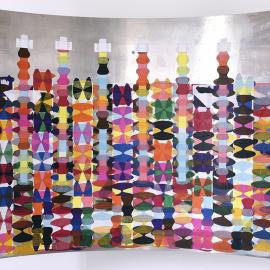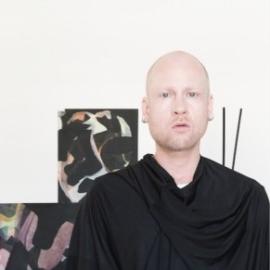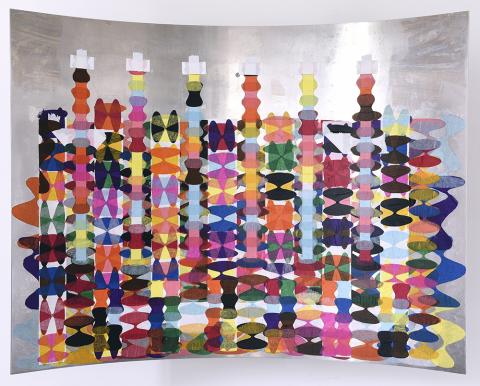Björn Streeck
@bjorn_streeckhttps://bjornstreeck.de/


Born 1983 in Berlin. Lives and works in Berlin.
In boundless possibilities, boundless fear of them is usually included. People look for methods of making sense of and structuring their reality. Religion, myths, oracles or spiritual practices like the tarot seem to be means for the human need for clarification.
Björn Streeck's works are interpretative tools for the ambiguities of our reality and the apparent unbridgeability of living together in it. They are, so to speak, helpers for self-knowledge and knowledge of others. Information that Streeck gathers in everyday life, his surroundings, with his family and friends, and that emerges in the exchange of inside and outside, social togetherness and its discrepancies, serve him as utensils. His works are images of the ordering of this information.
Mainly Streeck works on and with paper or other flat materials, which grow into multilayered entities on the surface of the picture. The superimposition of different material and formal levels is a decisive means in the artistic production process and the effect of the works. In them, forms, surface structures, materials and colors meet, interweave and react with each other. In this way, they become an analogy of reality in which things, subjects, and immaterial things constantly encounter, approach, overlap, or demarcate each other.
Streeck's works seem like a cipher of these complex networks and thus not only represent the order of information, but are also to be understood as concrete attempts at communication. Figures are in a constant mode of transition between concrete form and its dissolution. Streeck fixes this moment of threshold state, which is a constant condition of everyday reality for all those involved in it. Analogously, the works themselves emerge in ongoing processes, material extensions, coincidences, and transformations, which until the end create the impression that the images are in a never-completed state, from which Streeck depicts a snapshot.
At the same time, however, the flat medium never denies itself, for although the works sometimes create an effect of depth and object character through various layers of material and form, Streeck at no point designs an illusory or ideal space. The viewer looks at material, flat and above all pictorial references of complex networks of our reality. Thereby Streeck's works are flat, object-like, pictorial, abstract and figurative at the same time. With his art, he thus obstructs an exact classification and keeps himself as an artist as well as his works in a constant, never completed in-between state.
The images as tools of interpretation are and remain in themselves images of ambiguity. That is why they become projection surfaces and allow a parallelism to emerge between what is depicted in the pictures and events and questions in the life of the viewer.
This allows an insight into Björn Streeck's idea of worldview, in which everything, all of us, including Streeck himself and his artworks are "only" tools in a larger jumble.
Text by Sina Jentzsch 2019
In boundless possibilities, boundless fear of them is usually included. People look for methods of making sense of and structuring their reality. Religion, myths, oracles or spiritual practices like the tarot seem to be means for the human need for clarification.
Björn Streeck's works are interpretative tools for the ambiguities of our reality and the apparent unbridgeability of living together in it. They are, so to speak, helpers for self-knowledge and knowledge of others. Information that Streeck gathers in everyday life, his surroundings, with his family and friends, and that emerges in the exchange of inside and outside, social togetherness and its discrepancies, serve him as utensils. His works are images of the ordering of this information.
Mainly Streeck works on and with paper or other flat materials, which grow into multilayered entities on the surface of the picture. The superimposition of different material and formal levels is a decisive means in the artistic production process and the effect of the works. In them, forms, surface structures, materials and colors meet, interweave and react with each other. In this way, they become an analogy of reality in which things, subjects, and immaterial things constantly encounter, approach, overlap, or demarcate each other.
Streeck's works seem like a cipher of these complex networks and thus not only represent the order of information, but are also to be understood as concrete attempts at communication. Figures are in a constant mode of transition between concrete form and its dissolution. Streeck fixes this moment of threshold state, which is a constant condition of everyday reality for all those involved in it. Analogously, the works themselves emerge in ongoing processes, material extensions, coincidences, and transformations, which until the end create the impression that the images are in a never-completed state, from which Streeck depicts a snapshot.
At the same time, however, the flat medium never denies itself, for although the works sometimes create an effect of depth and object character through various layers of material and form, Streeck at no point designs an illusory or ideal space. The viewer looks at material, flat and above all pictorial references of complex networks of our reality. Thereby Streeck's works are flat, object-like, pictorial, abstract and figurative at the same time. With his art, he thus obstructs an exact classification and keeps himself as an artist as well as his works in a constant, never completed in-between state.
The images as tools of interpretation are and remain in themselves images of ambiguity. That is why they become projection surfaces and allow a parallelism to emerge between what is depicted in the pictures and events and questions in the life of the viewer.
This allows an insight into Björn Streeck's idea of worldview, in which everything, all of us, including Streeck himself and his artworks are "only" tools in a larger jumble.
Text by Sina Jentzsch 2019


